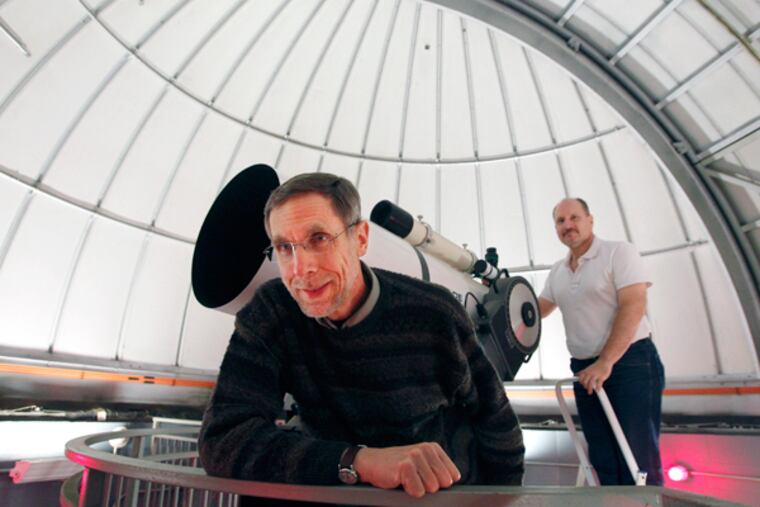Monday and Friday are stargazing nights at Widener observatory
Through the wide opening in a rooftop dome on the engineering building at Widener University, the most prominent feature of the view is a brilliantly lit Days I nn billboard. Focus a bit more, and you'll notice a cellphone tower, a patchwork of illuminated city buildings, and an airplane blinking across a grayish night sky.

Through the wide opening in a rooftop dome on the engineering building at Widener University, the most prominent feature of the view is a brilliantly lit Days Inn billboard. Focus a bit more, and you'll notice a cellphone tower, a patchwork of illuminated city buildings, and an airplane blinking across a grayish night sky.
Harry Augensen has made it his mission to show residents of Chester that there are stars there, too. On many Monday and Friday evenings, he invites community members of all ages to the roof of Kirkbride Hall, where he runs Widener's observatory. He and his helpers open the dome, focus their high-powered telescope, and show the attendees a night sky they have never seen over Chester before.
Recently, he pointed the 16-inch Meade Cassegrain reflecting telescope at Uranus, the constellation Pegasus, and a cluster of stars that he told the stargazers was 32,000 light-years away from Earth. Lillian Freeman, 48, rushed to the telescope to get a good look.
Freeman, of Chester, started attending Augensen's free public stargazing nights five years ago. "I'm very close to my creator. I wanted to see his creations and show my appreciation," she said. She has brought her friends to Widener to see the same stars, and Augensen has taught her to pick some out with the naked eye from her own front porch. "I think that's the most amazing thing, to now look up and know what you're looking at. I feel like my own world is open to me now."
Augensen said that 600 to 800 visitors like Freeman visit the observatory each year. Many come as part of class groups or Boy or Girl Scout troops.
Jasveer Singh of Ridley Township brought his four children, ages 2, 3, 5, and 11. "I wanted the kids to know something new, to learn about physics," he said.
Heavily bundled in puffy coats, the children jumped up and down to keep warm in the 25-degree temperature in the open-air observatory. The younger ones stood on a stepladder to reach the telescope. "Look, Mommy, look," the 3-year-old exclaimed when she got her turn.
"It was pretty cool," 11-year-old Navkaran said. "It was like, all this space. And then there was a light in the middle."
Several other universities in the area, including Eastern, Swarthmore, and Villanova, host similar public stargazing sessions in their observatories, but Widener is the most urban among them. Augensen, an astronomy professor at Widener for 32 years who mounted a long campaign for this observatory until it opened in 2005 as part of a new $12 million science wing, acknowledged that stargazers - both researchers and amateurs - can see less in brightly lit Chester than a darker rural area. But he praised the Widener observatory precisely because of its location.
"You have to be where it's convenient for people," he said. "They don't realize the planets are out there. Now they can see them with their own eyes."